The best preparation for the Microsoft Specialty AZ-220 exam definitely requires guidance from an effective Microsoft Azure IoT Developer preparation guide. It is highly recommended to learn all the details of the new AZ-220 dumps, which will help you pass the AZ-220 exam well.
It would be futile for a person to venture out without the new Microsoft AZ-220 dumps as a guide to effective Preparation for Microsoft Azure IoT developers. Pass4itSure AZ-220 dumps collect all relevant AZ-220 exam questions and answers in two displays, which can be found here: https://www.pass4itsure.com/az-220.html Updated AZ-220 dumps Q&A 136+ to ensure that you can pass the AZ-220 exam smoothly and easily.
The new AZ-220 dumps are perfect for your Microsoft Azure IoT Developer exam.
Free Microsoft AZ-220 dumps online download address: https://drive.google.com/file/d/1y5y74FdpsphbbjBdI5DIFNcB3SyTlmi4/view?usp=sharing
Why does the Microsoft Azure IoT Developer exam improve your position?
An increasing number of IT workers are being recommended to pass the Microsoft Azure IoT Developer exam and earn the Microsoft Specialty certification, enabling them to have the expertise to implement the configuration and coding tasks required to create and maintain the cloud and edge parts of IoT solutions. In this way, they will be more competitive in the workplace, better stand on their feet, and get higher promotions.
What do you need to grasp for the Microsoft AZ-220 exam?
As mentioned at the beginning, in addition to the effective AZ-220 dumps for the Microsoft Azure IoT Developer preparation guide, you also need to understand the basic requirements and topics for the exam:
Abbreviation: AZ-220
Full Name: Microsoft Azure IoT Developer
Passing Score: 700
Languages: English, Japanese, Korean, French, Spanish, Portuguese (Brazil), Russian, Arabic (Saudi Arabia), Chinese (Simplified), Italian, German, Chinese (Traditional)
Measure knowledge: Ability to set up IoT solution infrastructure; provision and manage devices; implement IoT edge; process and manage data; monitor, troubleshoot, and optimize IoT solutions; implement security.
Related Certifications: Microsoft Certified: Azure IoT Developer Specialty
Prerequisites: Have a general understanding of device types and Azure services
AZ-220 Dumps: Pass4itSure AZ-220 dumps (Q&As: 136)
Microsoft Security, what do you need to know?
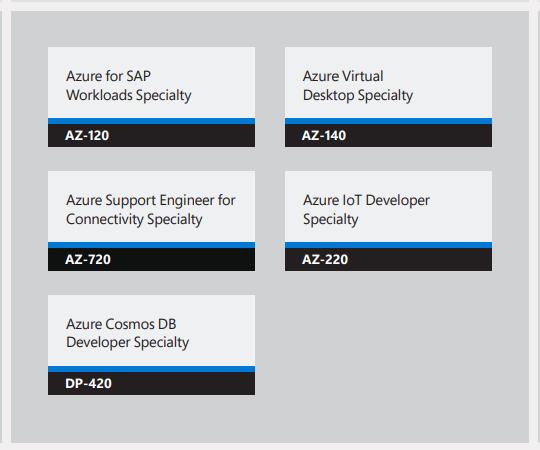
Exams required for all Microsoft Specialty certifications are listed below:
DP-420: Designing and Implementing Cloud-Native Applications Using Microsoft Azure Cosmos DB
AZ-140: Configuring and Operating Windows Virtual Desktop on Microsoft Azure
AZ-220: Microsoft Azure IoT Developer
AZ-120: Planning and Administering Microsoft Azure for SAP Workloads
AZ-720: Azure Support Engineer for Connectivity Specialty
Back to the topic, let’s talk about the Microsoft Certified: Azure IoT Developer Specialty certification path for the AZ-220 exam:

Microsoft Certified: Azure IoT Developer Specialty: Azure IoT developers develop cloud and edge components of Azure IoT solutions.
Where can I get free AZ-220 dumps practice?
AZ-220 Free Dumps Questions And Answers 1-13
Question # 1
HOTSPOT
You are planning a proof of concept (POC) that will use an Azure IoT hub. You have two self-signed client authentication certificates named Cert1 and Cert2. Cert1 has a basic constraint that contains Subject Type=CA. Cert2 has a basic constraint that contains Subject Type=End Entity.
You need to identify which certificates to use. What should you identify? To answer, select the appropriate options in the answer area. NOTE: Each correct selection is worth one point.
Hot Area:
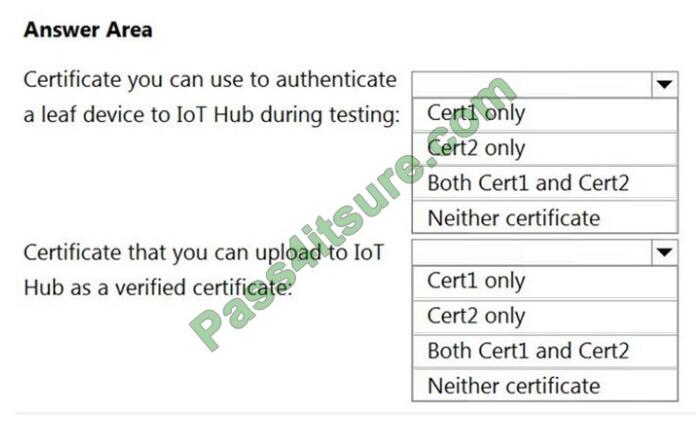
Answer:
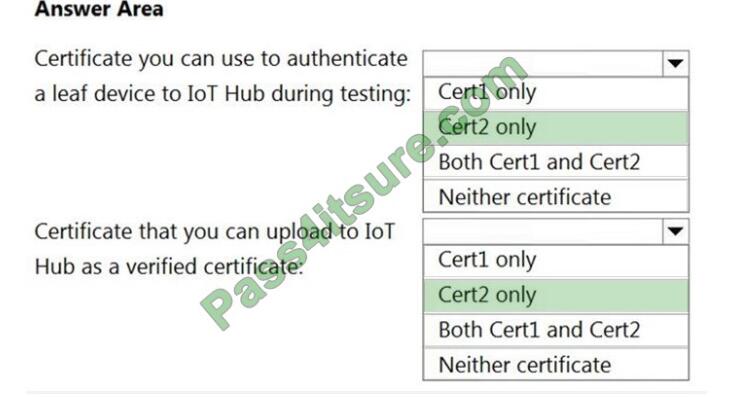
Box 1: Cert2 only Cert2: The leaf certificate, or end-entity certificate, identifies the certificate holder. It has the root certificate in its certificate chain as well as zero or more intermediate certificates. The leaf certificate is not used to sign any other certificates. It uniquely identifies the device to the provisioning service and is sometimes referred to as the device certificate.
Box 2: Cert1 only Cert1: A root certificate is a self-signed X.509 certificate representing a certificate authority (CA). It is the terminus, or trust anchor, of the certificate chain. Root certificates can be self-issued by an organization or purchased from a root certificate authority.
Reference: https://docs.microsoft.com/en-us/azure/iot-dps/concepts-x509-attestation
QUESTION # 2
You have an Azure IoT Central application. You add an IoT device named Oven1 to the application. Oven1 uses an IoT Central template for industrial ovens. You need to send an email to the managers group at your company as soon as the oven temperature falls below 400 degrees.
Which two actions should you perform? Each correct answer presents part of the solution.
NOTE: Each correct selection is worth one point.
A. Create a SendGrid account in the same resource group as the IoT Central application.
B. Add a condition that has Time Aggregation set to Off.
C. Add a condition that has Aggregation set to Minimum.
D. Add the Manager role to the IoT Central application.
E. From IoT Central, create a telemetry rule for the template.
Answer: BE
Devices use telemetry to send numerical data from the device. A rule triggers when the selected telemetry crosses a specified threshold.
E: To create a telemetry rule, the device template must include at least one telemetry value. The rule monitors the temperature reported by the device and sends an email when it falls below 400 degrees.
B: Configure the rule conditions.
Conditions define the criteria that the rule monitors. In this tutorial, you configure the rule to fire when the temperature exceeds 70?F.
1. Select Temperature in the Telemetry dropdown.
2. Next, choose Is less than as the Operator and enter 400 as the Value.
3. Optionally, you can set a Time aggregation. When you select a time aggregation, you must also select an aggregation type, such as average or sum from the aggregation drop-down.
Without aggregation, the rule triggers for each telemetry data point that meets the condition.
With aggregation, the rule triggers if the aggregate value of the telemetry data points in the time window meets the condition.
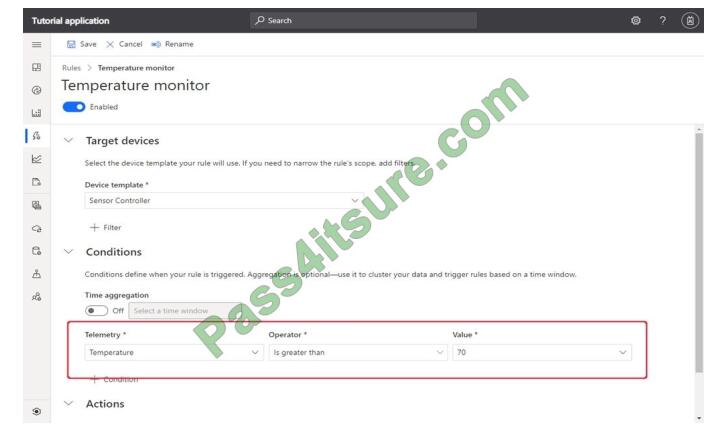
Reference: https://docs.microsoft.com/en-us/azure/iot-central/core/tutorial-create-telemetry-rules
QUESTION # 3
DRAG DROP
Your company is creating a new camera security system that will use Azure IoT Hub.
You plan to use an Azure IoT Edge device that will run Ubuntu Server 18.04.
You need to configure the IoT Edge device.
Which three actions should you perform in sequence? To answer, move the appropriate actions from the list of actions to the answer area and arrange them in the correct order.
Select and Place:
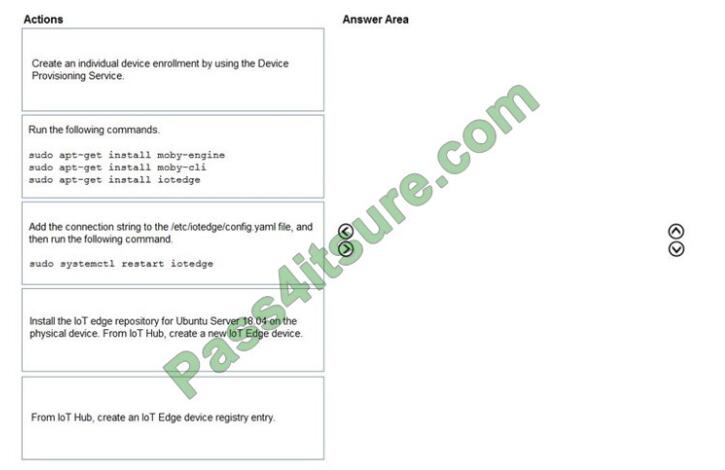
Answer:
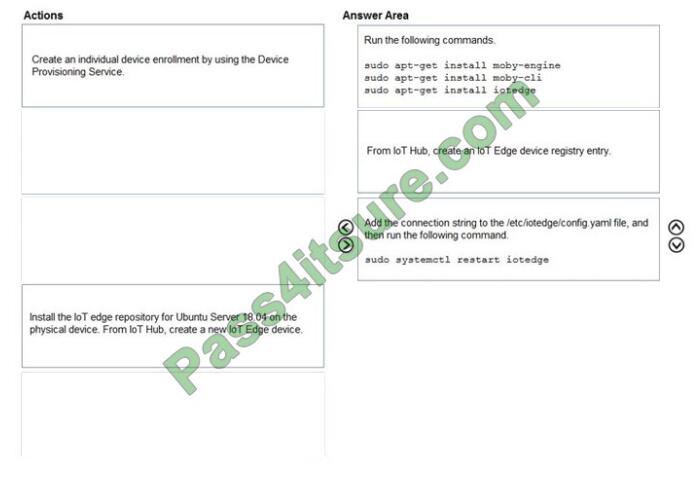
Step 1: Run the following commands Install the container runtime. Azure IoT Edge relies on an OCI-compatible container runtime. For production scenarios, we recommended that you use the Moby-based engine provided below. The Moby engine is the only container engine officially supported with Azure IoT Edge. Docker CE/EE container images are compatible with the Moby runtime.
Install the Moby engine. sudo apt-get install moby-engine Install the Moby command-line interface (CLI). The CLI is useful for development but optional for production deployments. sudo apt-get install moby-cli Install the security daemon. The package is installed at /etc/iotedge/. sudo apt-get install iotedge.
Step 2: From Iot Hub,create an IoT Edge device registry entry.
Note: In your IoT Hub in the Azure portal, IoT Edge devices are created and managed separately from IOT devices that are not edge enabled. Sign in to the Azure portal and navigate to your IoT hub.
In the left pane, select IoT Edge from the menu.
Select Add an IoT Edge device. Provide a descriptive device ID. Use the default settings to auto-generate authentication keys and connect the new device to your hub. Select Save.
Retrieve the connection string in the Azure portal
1. When you\\’re ready to set up your device, you need the connection string that links your physical device with its identity in the IoT hub.
2. From the IoT Edge page in the portal, click on the device ID from the list of IoT Edge devices.
3. Copy the value of either Primary Connection String or Secondary Connection String.
Step 3: Add the connection string to..
To manually provision a device, you need to provide it with a device connection string that you can create by registering a new device in your IoT hub. Open the configuration file. sudo nano/etc/iotedge/config.yaml
Find the provisioning configurations of the file and uncomment the Manual provisioning configuration section. Update the value of device_connection_string with the connection string from your IoT Edge device. Save and close the file. After entering the provisioning information in the configuration file, restart the daemon: sudo systemctl restart iotedge
Reference:
https://docs.microsoft.com/en-us/azure/iot-edge/how-to-install-iot-edge-linux
QUESTION # 4
You need to configure Stream Analytics to meet the POV requirements.
What are two ways to achieve the goal? Each correct answer presents a complete solution.
NOTE: Each correct selection is worth one point.
A. From IoT Hub, create a custom event hub endpoint, and then configure the endpoint as an input to Stream Analytics.
B. Create a Stream Analytics module, and then deploy the module to all IoT Edge devices in the fleet.
C. Create an input in Stream Analytics that uses the built-in events endpoint of IoT Hub as the source.
D. Route telemetry to an Azure Blob storage custom endpoint, and then configure the Blob storage as a reference input for Stream Analytics.
Answer: AC
QUESTION # 5
HOTSPOT
You have an Azure IoT Central application that has a custom device template.
You need to configure the device template to support the following activities:
Return the reported power consumption.
Configure the desired fan speed.
Run the device reset routine.
Read the fan serial number.
Which option should you use for each activity? Each correct answer presents part of the solution.
NOTE: Each correct selection is worth one point.
Hot Area:
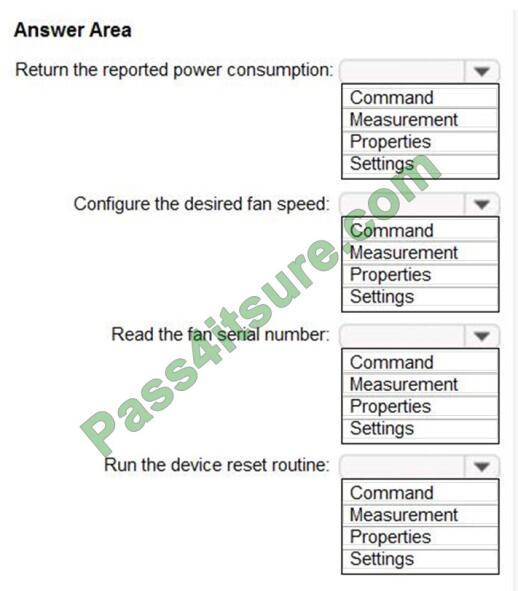
Answer:
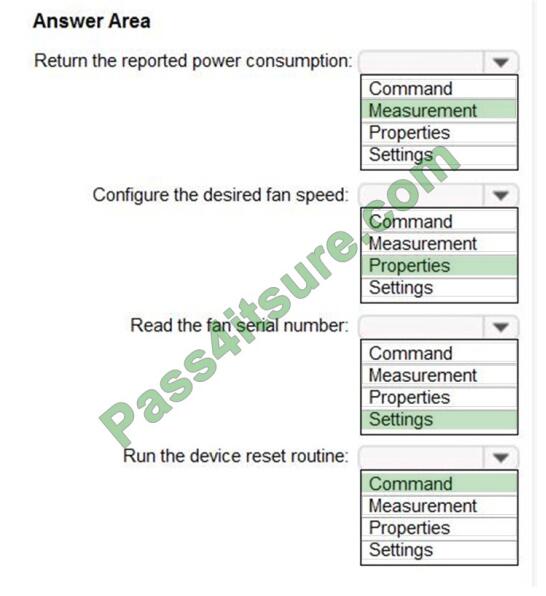
Box 1: Measurement
Telemetry/measurement is a stream of values sent from the device, typically from a sensor. For example, a sensor might report the ambient temperature.
Box 2: Property
The template can provide a writeable fan speed property
Properties represent point-in-time values. For example, a device can use a property to report the target temperature it\’s trying to reach. You can set writeable properties from IoT Central.
Box 3: Settings
Box 4: Command
You can call device commands from IoT Central. Commands optionally pass parameters to the device and receive a response from the device. For example, you can call a command to reboot a device in 10 seconds.
Reference:
https://docs.microsoft.com/en-us/azure/iot-central/core/howto-set-up-template
QUESTION # 6
You have an existing Azure IoT hub.
You need to connect physical IoT devices to the IoT hub.
You are connecting the devices through a firewall that allows only port 443 and port 80.
Which of following three communication protocols can you use? Each correct answer presents a complete solution. NOTE: Each correct selection is worth one point.
A. HTTPS
B. MQTT
C. AMQP over WebSocket
D. MQTT over WebSocket
Answer: ACD
QUESTION # 7
You have 100 devices that connect to an Azure IoT hub named Hub1. The devices connect by using a symmetric key. You deploy an IoT hub named Hub2. You need to migrate 10 devices from Hub1 to Hub2. The solution must ensure that the devices retain the existing symmetric key. What should you do?
A. Add a desired property to the device twin of Hub2. Update the endpoint of the 10 devices to use Hub2.
B. Add a desired property to the device twin of Hub1. Recreate the device identity on Hub2.
C. Recreate the device identity on Hub2. Update the endpoint of the 10 devices to use Hub2.
D. Disable the 10 devices on Hub1. Update the endpoint of the 10 devices to use Hub2.
Answer: B
Desired properties. Used along with reported properties to synchronize device configuration or conditions. The solution back end can set desired properties, and the device app can read them. The device app can also receive notifications of changes in the desired properties.
Reference: https://docs.microsoft.com/en-us/azure/iot-hub/iot-hub-devguide-device-twins
QUESTION # 8
You are developing an Azure IoT Central application. You add a new custom device template to the application.
You need to add a fixed location value to the device template. The value must be updated by the physical IoT device, read-only to device operators, and not graphed by IoT Central. What should you add to the device template?
A. a Location property
B. a Location telemetry
C. a Cloud property
Answer: A
For example, a builder can create a device template for a connected fan that has the following characteristics: Sends temperature telemetry Sends location property
Reference: https://docs.microsoft.com/en-us/azure/iot-central/core/howto-set-up-template
QUESTION # 9
You have an Azure IoT Central application that monitors 100 IoT devices.
You need to generate alerts when the temperature of a device exceeds 100 degrees. The solution must meet the following requirements:
Minimize costs
Minimize deployment time
What should you do?
A. Perform a data export to Azure Service Bus.
B. Create an email property in the device templates.
C. Perform a data export to Azure Blob storage and create an Azure function.
D. Create a rule that uses an email action.
Answer: D
You can create rules in IoT Central that trigger actions, such as sending an email, in response to telemetry-based conditions, such as device temperature exceeding a threshold.
Reference: https://docs.microsoft.com/en-us/azure/iot-central/core/howto-configure-rules-advanced
QUESTION # 10
You have a Standard tier Azure IoT hub and a fleet of IoT devices.
The devices connect to the IoT hub by using either Message Queuing Telemetry Transport (MQTT) or Advanced Message Queuing Protocol (AMQP).
You need to send data to the IoT devices and each device must respond. Each device will require three minutes to process the data and respond.
Solution: You use cloud-to-device messages and watch the cloud-to-device feedback endpoint for successful acknowledgement. Does this meet the goal?
A. Yes
B. No
Answer: B
IoT Hub provides three options for device apps to expose functionality to a back-end app:
Twin\’s desired properties for long-running commands intended to put the device into a certain desired state. For example, set the telemetry send interval to 30 minutes.
Direct methods for communications that require immediate confirmation of the result. Direct methods are often used for interactive control of devices such as turning on a fan. Cloud-to-device messages for one-way notifications to the device app.
Reference:
https://docs.microsoft.com/en-us/azure/iot-hub/iot-hub-devguide-c2d-guidance
QUESTION # 11
DRAG DROP
You have an Azure IoT solution that includes an Azure IoT hub, a Device Provisioning Service instance, and 1,000 connected IoT devices. The IoT devices are allocated to tour enrollment groups. Each enrollment group is configured to use certificate attestation.
You need to decommission all the devices in a single enrollment group and the enrollment group itself.
Which three actions should you perform in sequence? To answer, move the appropriate actions from the list of actions to the answer area and arrange them in the correct order.
Select and Place:

Answer:

To deprovision all of the devices that have been provisioned through an enrollment group:
Disable the enrollment group to disallow its signing certificate.
Use the list of provisioned devices for that enrollment group to disable or delete each device from the identity registry of its respective IoT hub.
After disabling or deleting all devices from their respective IoT hubs, you can optionally delete the enrollment group. Be aware, though, that, if you delete the enrollment group and there is an enabled enrollment group for a signing certificate higher up in the certificate chain of one or more of the devices, those devices can re-enroll.
Reference:
https://docs.microsoft.com/en-us/azure/iot-dps/how-to-unprovision-devices
QUESTION # 12
DRAG DROP
You need to install the Azure IoT Edge runtime on a new device that runs Windows 10 IoT Enterprise.
Which four actions should you perform in sequence? To answer, move the appropriate actions from the list of actions to the answer area and arrange them in the correct order.
Answer:
Select and Place:
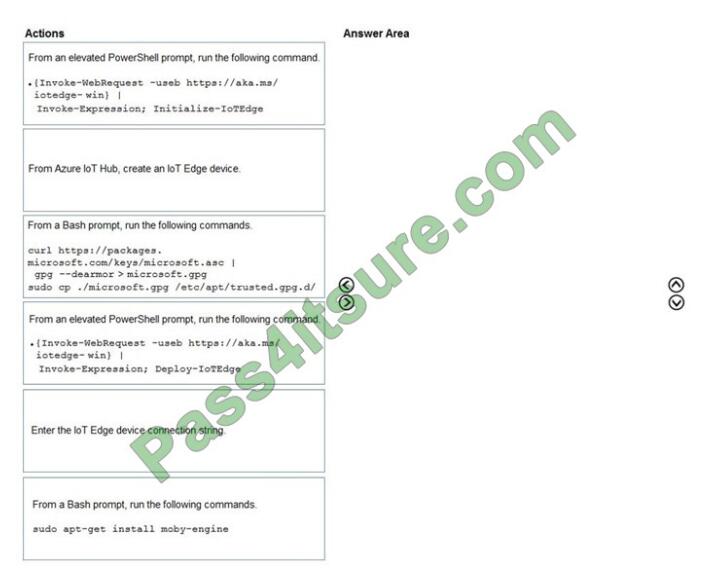
Answer:
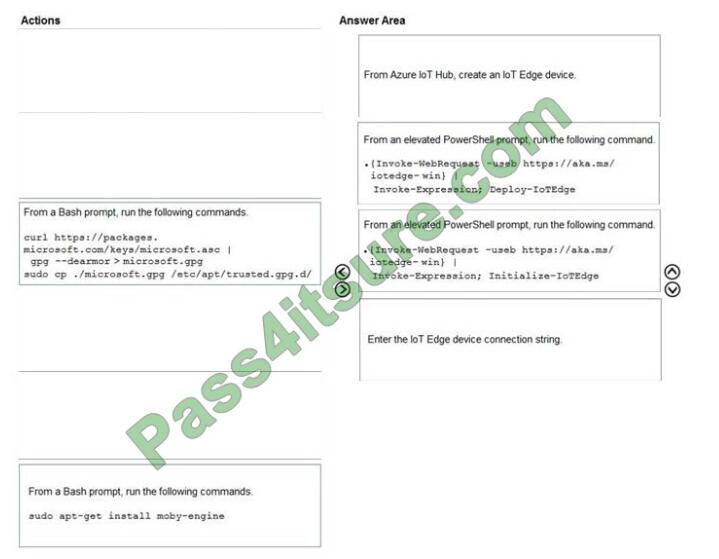
Step 1: From Azure IoT Hub, create an IoT Edge Device
Step 2: Deploy-IoTEdge
The Deploy-IoTEdge command checks that your Windows machine is on a supported version, turns on the containers feature, and then downloads the moby runtime and the IoT Edge runtime. The command defaults to using Windows containers. {Invoke-WebRequest -useb https://aka.ms/iotedge-win} | Invoke-Expression; `Deploy-IoTEdge
Step 3: Initialize-IoTEdge
The Initialize-IoTEdge command configures the IoT Edge runtime on your machine. The command defaults to manual provisioning with Windows containers. {Invoke-WebRequest -useb https://aka.ms/iotedge
Step 4: Enter the IoT Edge device connection string.
When prompted, provide the device connection string that you retrieved in step 1. The device connection string associates the physical device with a device ID in IoT Hub.
Reference:
https://docs.microsoft.com/en-us/azure/iot-edge/module-composition
QUESTION # 13
HOTSPOT
You create an Azure Stream Analytics job that has the following query.

The job is configured to have an Azure IoT Hub input and an output to an Azure function.
For each of the following statements, select Yes if the statement is true. Otherwise, select No.
NOTE: Each correct selection is worth one point.
Hot Area:
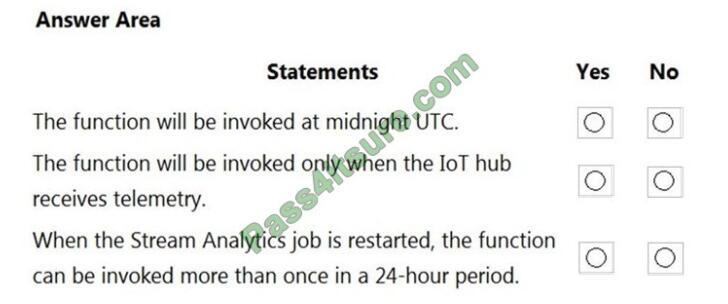
Answer:’
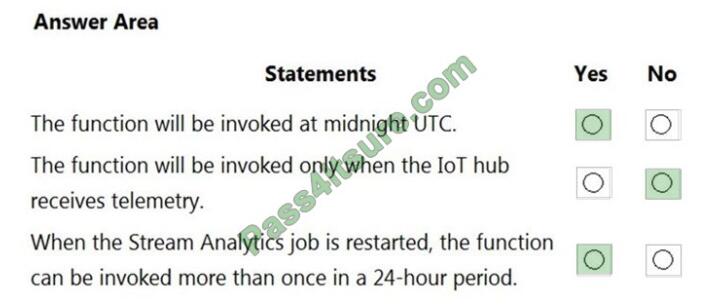
View More AZ-220 Questions, Here.